Hope that the Irish had turned a corner after the 0-2 start quickly evaporated on Saturday night, as Notre Dame’s horrific offensive effort led to a 2-point loss to a bad Stanford team. Drew Pyne played about as poorly as you can without throwing an interception, missing open shots at long gains, forcing passes late and into coverage, and getting stripped on one of two Cardinal sacks. The Irish defense put on respectable performance, especially battling injuries, but continues to struggle creating any havoc and getting off the field quickly.
After the last two games there was hope that the arrow on Marcus Freeman’s rookie year was firmly pointed up – that the offense had figured things out between Pyne getting cozy and the offensive line righting the ship, that the defense was solid if it could only tighten up a few lapses, and that by the end of the year we’d look up and the Irish would be in a bowl with a top-25 rankings (human and power ranking).
It turns out that maybe when you factor in this current roster’s ceiling, floor, and inconsistency, it’s a pretty middling power five team.
College Football’s Most Efficient Teams through Week 7
🟢⬆️➡️: Good Offense, Good Defense
🔵⬆️⬅️: Good Offense, Defense Needs Work
🟡⬇️➡️: Bad Offense, Good Defense
🔴⬅️⬇️: We’re playing football games! pic.twitter.com/YFH9Ek90sE— parker (@statsowar) October 16, 2022
The cumulative EPA graph below tells the story of the game – Stanford plodded along on offense, doing just enough to create points and mostly avoiding costly mistakes. The Irish played abysmally on offense in the first half, started the correct course, but it was too late with a costly fumble and disjointed final drive sinking the change to salvage a win.
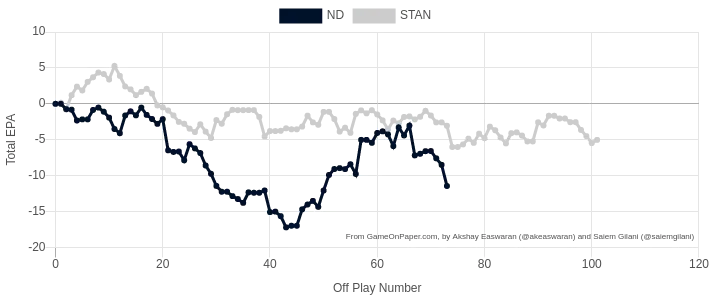
Stats from a few excellent sources – College Football Data, Game On Paper, and often referencing SP+ and FEI numbers. If you get lost, check out this handy advanced stats glossary here or reach out in the comments.
This was a toss-up game the Irish botched, not an outlier
SP+ had the post-game win expectancy at 77% for the Irish, leading to some questions if this was one of those games where everything went wrong but Notre Dame outplayed the opponent. Think the Virginia Tech game of 2019, where the Irish dominated most stat categories but had costly turnovers including a 98-yard fumble return for a touchdown.
This was not one of those games – efficiency and explosiveness were essentially a draw, and Stanford doubled up the Irish in creating scoring opportunities. David Shaw’s team averaged ten yards more per possession. Notre Dame was lucky that the Cardinal stalled out on so many drives and were forced to settle for field goals and that David Shaw punted away a late scoring opportunity.
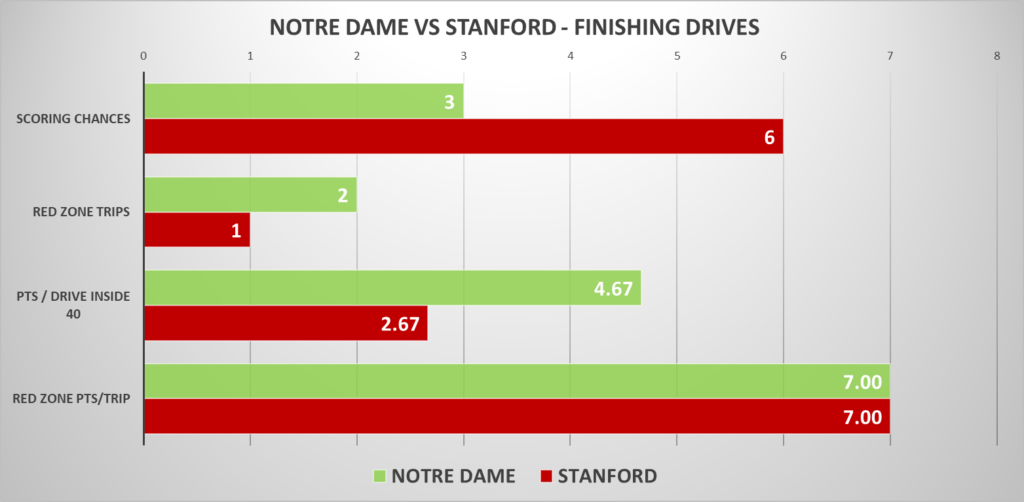
This is also a case where tracking these plays versus solely relying on a box score helps – my numbers remove Stanford kneel-downs (which slightly reduce their efficiency and yards per play), the incomplete Stanford shovel pass (for some reason counted as a fumble for no gain in the official box score), and didn’t give Audric Estime credit for the yards gained rushing from the point where he fumbled to where it was recovered.
Notre Dame also lost the turnover battle but wasn’t too unlucky, at least without counting the official reviews. The Irish fumbled three times and had six passes broken up, so they’d be projected to lose 2.82 turnovers and lost two. Stanford had only one official fumble after reviews and one pass broken up – the Irish continue to struggle creating opportunities for interceptions.
Could some of those reviews and penalty yards swayed this game? Absolutely. But this wasn’t a case where Notre Dame fans can play the bad luck card, at home they played down the level of a team currently rated 74th in F+.
An inexplicable, indefensible offensive effort
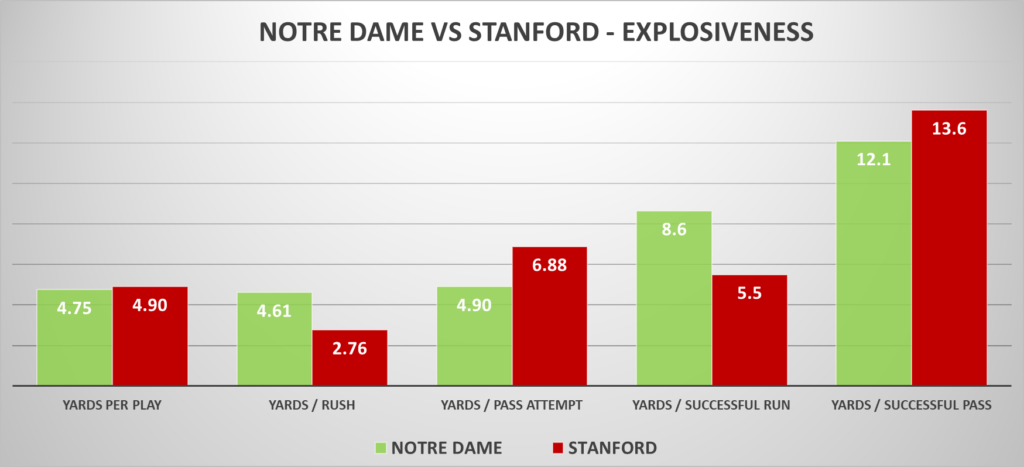
Stanford’s defense is one of the worst so far in the power five, with numbers against the run that rank among the worst in FBS as a whole. The ND point total over/under was around 36 points. Drew Pyne had looked sharp and led drives that ended in scoring opportunities on 17 of his last 20 possessions.
It all just makes the performance against the Cardinal incredibly confusing and depressing. It starts with Pyne struggling immensely, which seemed to trigger a bit of a Drew-Tommy death spiral of sorts. Errant passes and bad decisions seemed to lead to Rees running mostly conservative plays on 2nd and longs out of fear of putting Pyne into many long passing downs. Those fears were well founded, as Notre Dame was successful on just 3 of 16 passing downs for the game, but 3rd down also wasn’t much better (3 of 12). Worries about converting power run situations led to some poor calls and execution – the failed Jaden Thomas end around on 4th down, two 3rd and 2 incompletions.
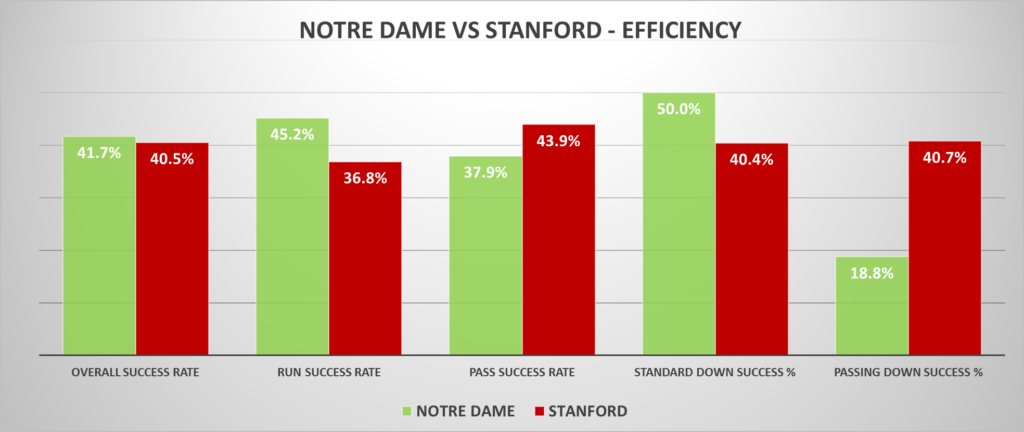
It was an offense that had no clear counterpunch when it failed to mash the Stanford DL as anticipated. The fallback was putting the entire weight of the offense on Michael Mayer, who was targeted on seven of ten 3rd down passes and caught only two of those attempts. The first half was completely miserable, with an averaged gain of 0.9 yards on first down plays, putting every drive in an early hole especially combined with offensive penalties (some earned, some terrible calls).
The defense gets a passing grade, but must do more
Notre Dame’s defense wasn’t the problem in this game. They successfully limited Stanford from pulling off the explosive plays that gashed the Irish in the UNC and BYU games, although the Cardinal personnel and scheme weren’t really aiming to take those shots. Still, Stanford averaged only 2.76 yards per carry with a long rush of nine yards. For most of the game Al Golden’s unit pulled off a passable bend but don’t break.
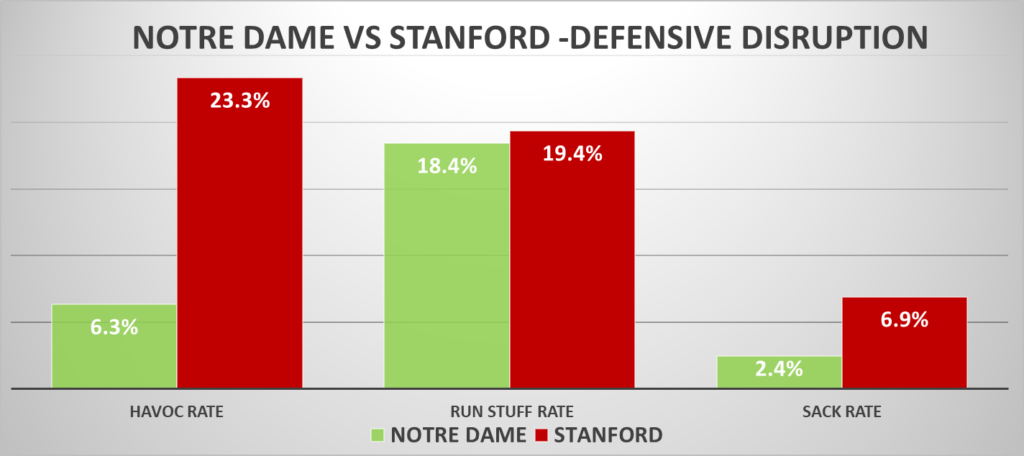
There is a little bit of a smoke and mirrors feel to it, however. Under Clark Lea the bend but don’t break was successful thanks to a few key factors – the Irish excelled on passing downs and third downs, still created these situations with plenty of disruption (run stuffs and pass break-ups), and clamped down on scoring opportunities and in the red zone.
This Notre Dame team is not doing these things:
ND 3rd down D last year: 10th. ND red zone TD % last year: 4th.
They are 70th and 129th in those two categories this season
— Jamie Uyeyama (@jamieuyeyama) October 17, 2022
- Opponent Line Yards Allowed: 92nd
- Run Stuff Rate: 54th
- Sack Rate: 23rd (one saving grace)
- Fumbles forced per game: 72nd
- Pass break-ups per game: 130th
A bend but don’t break that struggles to disrupt opponents means that you’re hoping you can hold offenses to short gains, and find stops on a lot of 3rd/4th and short situations. And the Irish have been pretty good there – 25th in opponent power run success allowed. But against better offenses the current formula seems unlikely to be very successful, and puts a lot of stress on the defense to win three downs in a row or hope for poor execution from the opponent.
The success of the Marcus Freeman era could hinge on the passing game, and time is already ticking
This has been a decade-long recurring topic for Notre Dame – it’s really hard to find and recruit an elite quarterback without a strong track record, scheme, or production to lean back on. Under Tommy Rees there’s been good things like maximizing Ian Book’s skillset, but also poor evaluation / luck with blue chip QBs and offenses lacking skill position weapons.
Competing for top prospects, Notre Dame has to be perfect developing relationships and a forward-looking pitch of what the offense will be. Meanwhile, other programs attempt do the same and can point to NFL draftees and gaudy numbers and All-American wide receivers. Until there’s a dynamic passing offense to point to, or a highly drafted QB, how do you win those battles against Ohio State, Alabama, USC, or even lower-tier programs like UNC and Ole Miss that consistently churn out productive QB seasons?
It feels like the Irish could get there if they could finally land the right guy and pair him with solid skill position talent. But time is ticking, and we’re seeing the effects immediately of what poor QB performances can do to lose games. With Pyne falling back to earth, Buchner’s injury, and still no leads on a ’23 QB, a grad transfer looks like a critical need. But how do you win the fierce competition for the quality players in the portal, for players with even more immediate needs? Can you sell them on a strong OL, Styles/Merriweather/Thomas and a stocked tight end room? That next year things will be different and you’ll air it out instead of go run-heavy with the “3-headed monster” at RB?
It seems like a knee-jerk reaction, but I’m not sure Freeman can waste an offseason before making moves that at least set the foundation for an offensive turnaround. CJ Carr could be brilliant and the long-term solution, but if he’s not equipped with the right surrounding talent and scheme it won’t lead the Irish to a new level. If you can’t sell a transfer on the current roster or scheme, maybe Freeman can tap into the hot trend of hiring an OC and importing as much of that offensive personnel as possible.
On to the unknown
If you watched this game immediately after the Marshall loss, it would have seemed like a logical follow-up for a team that seemed lost. With the UNC and BYU games sandwiched in between, the sum of the performances indicates a team that’s simply inconsistent and overall fairly average. It’s a team that’s not as bad as its worst moments but definitely not strong or complete enough to sustain peak performances for long either.
Everyone knew there would be potential growing pains with the Kelly to Freeman transition, and I think the vast majority of fans would gladly trade a couple extra losses this year for an increase in program potential down the road. But these struggles fairly call into question if Freeman will be able to capitalize on improved talent down the road if this roster is underachieving. And 5-6 losses this season could jeopardize that future potential if the recruiting efforts continue to stagnate or worse fall apart.
We can only hope that this season serves as something like BK’s 2016, and that there’s value to be gained from these close, terrible losses. Notre Dame could easily be 5-1 with massive underlying red flags unaddressed, and maybe these swings lead Freeman to make the right changes in season or this offseason. If Pyne isn’t going to work as a starter, have that be clear now versus a murky situation heading into next offseason.

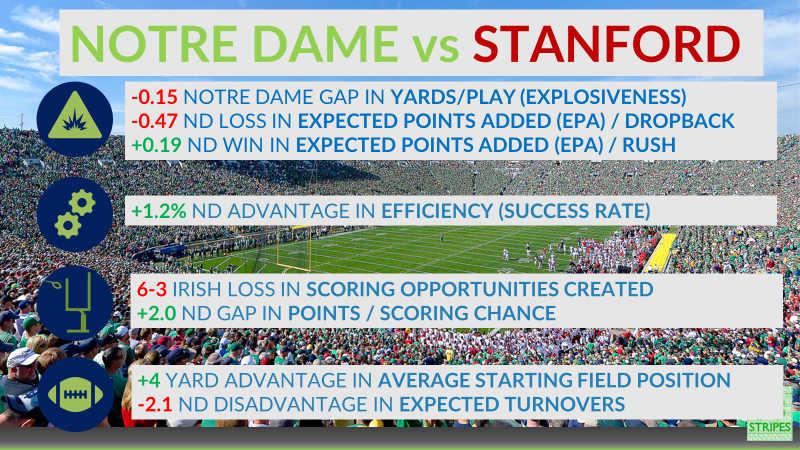
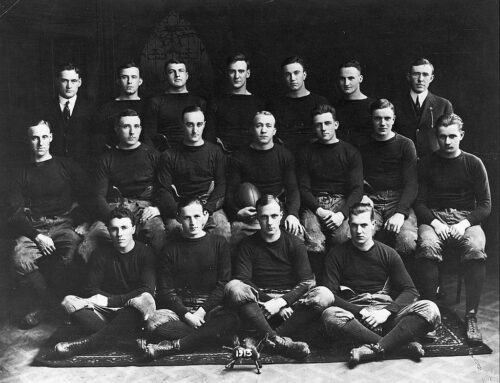


That graph at the top, man, bang average!
Thanks for another truly well done analysis, Michael. Dispiriting but that’s not your fault! The Tommy-Drew death spiral comment is most insightful. As was your throwing in the good explanation for why the 4th down endaround. (Though there we may note Marcus Freeman’s honest remark about Tommy saying “That’s not the look” as the play was about to start and MF saying maybe he should have called time there.)
My question is; “Why are we running a play that depends on them being in a specific look?”
Another question is: “Why did Rees wait so long to recognize that he wasn’t getting the look he wanted?”
Any offensive coordinator would look great if the opposing defense would line up in the “look” that the OC thought suitable.
Could not agree more with the underlying analysis here. Perhaps a shorter way of putting it is: ND probably needs an elite QB to get to the point where it could get to winning playoff semifinals, and why would an elite QB come play for Tommy Rees? That the question is rhetorical is a problem.